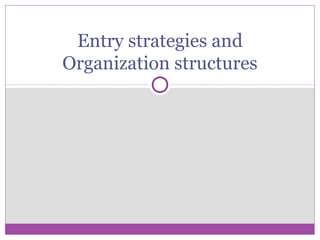
Organisation structures (2)
- 1. Entry strategies and Organization structures
- 2. Entry Strategies and Ownership Structures Export/import Wholly-owned subsidiary Mergers/acquisitions Alliances/joint ventures Licensing Franchising
- 3. Export/Import Often the only available choices for small and new firms wanting to go international Also permits larger firms to begin international expansion with minimum investment Paperwork can be turned over to export management company or through firm’s export department Permits easy access to overseas markets Strategy is usually transitional in nature
- 4. Wholly Owned Subsidiary Overseas operation is totally owned and controlled by an MNC MNC’s desire for total control and belief that managerial efficiency is better without outside partners Some host countries concerned that MNC will drive out local enterprises Home country unions sometimes view foreign subsidiaries as an attempt to “export jobs” Today many MNCs opt for merger, alliance, or joint venture than a fully owned subsidiary
- 5. Mergers and Acquisitions The cross-border purchase or exchange of equity involving two or more companies The strategic plan of merged companies often calls for each to contribute a series of strengths toward making the firm a highly competitive operation
- 6. Alliances and Joint Ventures Alliance Any type of cooperative relationship among different firms International joint venture (IJV) Agreement under which two or more partners from different countries own or control a business Nonequity venture Equity joint venture Advantages Improvement of efficiency Access to knowledge Political factors Collusion or restriction in competition
- 7. Strategic Alliance Recommendations 1. Know partner well before alliance is formed. 2. Expect differences in alliance objectives among potential partners headquartered in different countries. 3. Having desired resource profiles does not guarantee other has complementary to firm’s resources. 4. Be sensitive to alliance partner needs. 5. After identify best partner, work on developing relationship of trust.
- 8. Licensing License is an agreement that allows one party to use an industrial property right in exchange for payment to other party Licensee may avoid entry costs by licensing to a firm already there Licensor usually is a small firm lacking financial and managerial resources Companies spending large share of revenues of R&D are likely to be licensors Companies spending very little on R&D are more likely to be licensees
- 9. Franchising Franchise: one party (the franchisor) permits another (the franchisee) to operate an enterprise using its trademark, logo, product line, and method of operation in return for a fee Widely used in fast-food and hotel/motel industries With minor adjustments for local market, can result in highly profitable international business.
- 10. Basic Organizational Structures Initial Division Structures Export arrangement Common among manufacturing firms, especially those with technologically advanced products On-site manufacturing operations In response to local governments when sales increase Need to reduce transportation cost Subsidiary Common for finance-related businesses or other operations that require onsite presence from start
- 12. International Division Structure Structural arrangement that handles all international operations out of a division created for this purpose Assures international focus receives top management attention Unified approach to international operations Often adopted by firms still in developmental states of international business operations Separates domestic from international managers (not good) May find it difficult to think and act strategically, or to allocate resources on a global basis
- 14. Global Structural Arrangements Global Product Division Structural arrangement in which domestic divisions are given worldwide responsibility for product groups Global product divisions operate as profit centers Helps manage product, technology, customer diversity Ability to cater to local needs Marketing, production and finance coordinated on product-by- product global basis Duplication of facilities and staff personnel within divisions Division manager may pursue currently attractive geographic prospects and neglect others with long-term potential Division managers may spend too much time tapping local rather than international markets
- 16. Global Area Division Structure under which global operations organized on geographic basis International operations put on same level as domestic Global division mangers responsible for all business operations in designated geographic area Often used by firms in mature businesses with narrow product lines Firm is able to reduce cost per unit and price competitively by manufacturing in a region Difficult to reconcile a product emphasis with geographic orientation New R&D efforts often ignored because divisions are selling in mature market
- 17. Global Area Division Structure
- 18. Global Functional Division Structure Structure that organizes worldwide operations primarily based on function and secondarily on product Approach not used except by extractive companies such as oil and mining Favored only by firms needing tight, centralized coordination and control of integrated production processes and firms involved in transporting products and raw materials between geographic areas Emphasizes functional expertise, centralized control, relatively lean managerial staff Coordination of manufacturing and marketing often difficult Managing multiple product lines can be very challenging because of separation of production and marketing into different departments.
- 19. Global Functional Division Structure
- 20. Mixed Organizational Structures Structure is a combination of global product, area, or functional arrangements Allows organization to create specific type of design that best meets its needs As matrix design’s complexity increases, coordinating personnel and getting everyone to work toward common goals often become difficult Too many groups to their own way
- 22. Transnational Network Structures Multinational structural arrangement combining elements of function, product, geographic design, while relying on network arrangement to link worldwide subsidiaries At center of transnational network structures are nodes, units charged with coordinating product, functional, and geographic information Different product line units and geographic area units have different structures depending on what is best for their particular operation
- 25. Multinational Enterprise Organizational Structure Nestle’s organization chart